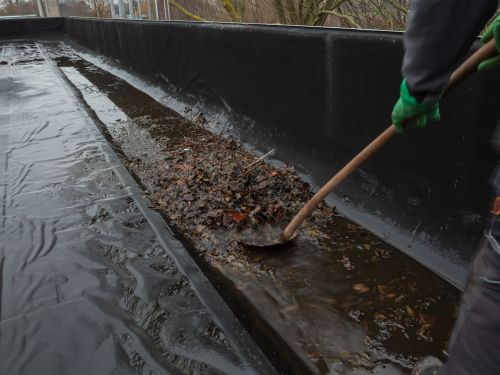Why Proper Drainage is Essential for Flat Roofs
Flat roofs are a popular choice for Portland homes, garages, ADUs, and modern architectural designs—but they come with unique drainage challenges in the Pacific Northwest. With Portland’s heavy rainfall, frequent mist, and damp winters, flat roofs must be engineered with effective drainage systems to prevent ponding water, leaks, and premature roof deterioration. Without proper planning, even small drainage issues can lead to costly repairs, structural damage, and mold growth.

This guide covers the most important flat roof drainage design tips to protect your home or garage and keep your roof performing reliably in rainy climates.
Unsure if Your Homes Drainage System is Efficient?
Why Drainage Matters for Flat Roofs in Portland
Unlike pitched roofs that naturally shed water, flat roofs rely on carefully designed drainage systems to move water off the surface. Even a “flat” roof has a slight slope, usually between 1/4” to 1/2” per foot, to allow proper water flow.
Preventing Ponding Water
Ponding occurs when water sits on the roof for more than 48 hours. In Portland’s climate, this is a common issue that can lead to:
- Membrane deterioration
- Increased leak risk
- Added stress on roof framing
- Faster aging due to UV exposure
Reducing Leak Potential
Flat roofs have more seams, flashing points, and penetrations than sloped roofs. Standing water increases the likelihood that moisture will find its way into these vulnerable areas.
Protecting Insulation and Roof Structure
Waterlogged insulation loses its effectiveness and can cause rot in wooden roof decks or joists.
If you’re experiencing ponding water or drainage issues, HER Roofing offers expert flat roof inspections and repair services to keep your home protected.
Key Flat Roof Drainage Design Options
Several drainage systems can be used to manage water efficiently on Portland’s flat roofs. The right solution depends on your roof’s size, slope, and structural design.
Internal Drains
Often used on commercial-style or larger flat roofs, internal drains collect water through openings in the roof and carry it through pipes hidden inside the building.
Benefits:
- Hidden from view for a clean look
- Effective for large roof areas
- Reduce water flow along exterior walls
To function properly, internal drains must be paired with strainers to prevent clogging from leaves and debris.
Scuppers
Scuppers are openings in the parapet walls that allow water to drain off the edges of the roof and into downspouts or splash blocks.
Benefits:
- Simple and low maintenance
- Highly effective for sudden heavy rainfall
- Work well for homes and garages with parapet walls
Scuppers should be sized properly so they don’t overflow during severe storms.
Overflow Drains
Overflow drains serve as a backup system if the primary drainage becomes blocked. They sit higher than the main drain to prevent water from rising to dangerous levels.
Tapered Insulation
Tapered insulation creates slope across the roof, helping direct water toward drains or scuppers. This is one of the most effective solutions for preventing ponding water on older or previously flat roof systems.
Gutters for Flat Roof Edges
In some residential flat roofs, gutters and downspouts can be installed along edges to capture runoff and redirect water safely away from the structure.
If you’re unsure which drainage design fits your home or garage, HER Roofing’s team can evaluate your flat roof and recommend the most effective, long-lasting solution.
Maintenance Tips to Prevent Ponding and Leaks
Even the best-designed flat roof requires routine maintenance—especially in Portland’s rainy environment.
Clear Debris Regularly
Leaves, moss, needles, and twigs can block drains and scuppers, causing water to back up. Inspect your roof seasonally, especially after storms.
Check Flashing and Seams
Water often finds its way into weak points where roofing materials meet. Ensure all seams are sealed and flashing is intact.
Ensure Proper Slope
Over time, flat roofs can settle or sag. If low spots develop, they must be corrected with tapered insulation or structural adjustments.
Monitor for Soft Spots
Soft or spongy areas indicate water intrusion beneath the membrane. Early detection prevents major damage.
Schedule Annual Roof Inspections
Professional inspections help identify drainage issues before they turn into leaks or structural problems—critical in wet regions like the Pacific Northwest.
Keep Your Flat Roof Safe With Proper Drainage Design
Flat roofs require thoughtful drainage planning to stay leak-free and durable in Portland’s rainy climate. With the right combination of design, materials, and maintenance, you can prevent ponding water, protect your home or garage, and extend the lifespan of your entire roofing system.
Need help with flat roof drainage? Contact HER Roofing today for expert design, repair, and inspection services tailored to Portland’s unique weather challenges.

